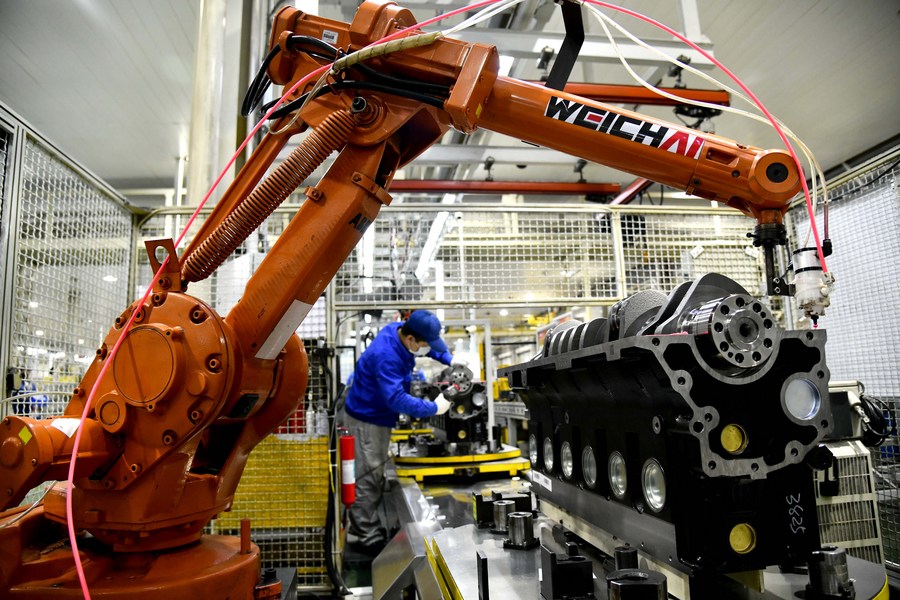?Reviewing the successes of China's 13th Five-Year Plan
- ?By Jon Taylor
 0 Comment(s)
0 Comment(s) Print
Print E-mail China.org.cn, October 25, 2020
E-mail China.org.cn, October 25, 2020

China is in the global spotlight as the fifth plenary session of the 19th Central Committee of the Communist Party of China (CPC) will be held from Oct. 26-29. During the event, attendees will discuss and finalize the 14th Five Year Plan (2021-2025) as well as develop the nation's long-term economic blueprints through 2035. The final version will be released at the National People's Congress in March 2021.
China's five-year plans have often been called one of the world's most important policy documents. As the country's top policy blueprint, it plots China's course based on a set of goals on everything from economic growth to foreign policy, and agricultural production to sports.
The 14th Five-Year Plan will cover the first five years after China has completed the tasks laid out in the previous two plans to build a moderately prosperous society in all respects. Why is this significant? Because China's GDP and GDP per capita have more than doubled since 2010, and extreme poverty has sharply declined. As such, China can now reasonably claim to be a "moderately prosperous society," thereby meeting the first of its "two centenary goals".
Having achieved this goal, the 14th Five-Year Plan will serve as a blueprint for China's transition toward a high-income economy, prioritizing four areas: digitalization, further reform and opening of both the economy and financial markets, enhancing green development and environmental protection, and providing additional support for less developed areas of the country. These priorities are in keeping with China's second centenary goal of "national rejuvenation while building a modern socialist country that is prosperous, strong, democratic, culturally advanced, and harmonious by 2049." Before China embarks on its new plan, however, it is worth noting the significant contributions made by the 13th Five-Year Plan.

Admittedly, the U.S.-China trade war and COVID-19 pandemic have significantly affected China's economy during 2020 and made the 13th Five-Year Plan's objectives difficult to achieve. That said, most of these objectives have been met despite these twin headwinds. Specifically, a swift third quarter recovery in 2020 will allow China to reach almost all of its goals by the end of this year – including annual GDP growth of 6.5% and the doubling of average disposable income.
During the past five years, China has implemented supply-side reforms and enacted deleveraging measures. One of the principal goals of the 13th Five-Year Plan was to develop a more innovative, coordinated, green, open and inclusive approach to growth in order to create a moderately prosperous society.
Consider the following: In 2006, China's GDP accounted for about 5.3% of the world's total. By 2020 it will be roughly 17%. China's growth constitutes around 30% of global economic growth this year and it currently has the strongest momentum as we head into the final quarter. Simply put, China will continue to be a primary engine of global economic growth, as stated in the 13th Five-Year Plan.
But how has this economic growth been achieved? By leveraging the burgeoning economic power of eastern coastal cities and provinces, and combining them with other regions in the country in order to balance regional development. During 2019, 11 provinces and cities in the Yangtze River Economic Belt saw rapid economic growth.

The 13th Five-Year Plan proposed the construction of the Belt and Road Initiative, and the development of the Beijing-Tianjin-Hebei region, Yangtze River Economic Belt, and Pearl River Delta. Under the policy directives of the 13th Five-Year Plan, the development of these urban regions has become a driving force in China.
China is now stronger, wealthier and better positioned globally, economically and socially. The 13th Five-Year Plan was formulated during a significant slowdown in global economic growth when the country was facing critical challenges of income inequality, urbanization, evolving demographics, environmental pollution, and the need to move toward a service- and innovation-driven economy. These factors required it to address domestic demand-driven growth and move away from export-led growth. The 13th Five-Year Plan was aimed at liberalizing China's economy, shifting it towards consumption-driven growth, and allowing the market to play a greater role in allocating resources. As a result, China has been able to simplify its financial regulations, making it easier for foreign financial institutions to enter the Chinese market.
While China has not completely resolved all its challenges, the 13th Five-Year Plan has set the stage for the deepening of economic and social development as the country looks to become a high-income economy.
China has grown rapidly during the past decade and achieved its national objectives under the 13th Five-Year Plan. The next step is to achieve national rejuvenation by 2049, which means starting with the 14th Five-year Plan, and continuing to expand domestic development and prosperity.
Jon Taylor is Chair of the Department of Political Science and Geography and Professor of Political Science at the University of Texas at San Antonio.
Opinion articles reflect the views of their authors only, not necessarily those of China.org.cn.
If you would like to contribute, please contact us at opinion@china.org.cn.





